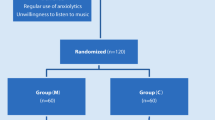Abstract
PURPOSE: Patient anxiety related to flexible sigmoidoscopy can negatively affect acceptability and compliance with screening protocol, complicate and prolong procedure time, and potentially result in prematurely aborted procedures. Music has been recognized through research as a safe, inexpensive, and effective nonpharmaceutical anxiolitic agent. METHODS: An experimental study was performed on 50 adults scheduled for outpatient sigmoidoscopy. The control group received standard sigmoidoscopy protocol. Subjects in the experimental group received the standard protocol with the addition of listening to music throughout the procedure. State-Trait Anxiety Inventory (STAI) measurements were performed on all subjects before and postsigmoidoscopy. Physiologic recordings of heart rate and mean arterial pressure were recorded before and during the procedure. RESULTS: Patients who listened to self-selected music tapes during the procedure had significantly decreased STAI scores (P <0.002), heart rates (P <0.03), and mean arterial pressures (P <0.001) in comparison to the control subjects. CONCLUSION: The results of the study indicate that music is an effective anxiolitic adjunct to flexible sigmoidoscopy.
Similar content being viewed by others
References
Boring CC, Squires TS, Tong T. Cancer statistics, 1993. CA Cancer J Clin 1993;43:7–26.
Dukes CE. The classification of cancer of the rectum. J Pathol 1932;35:323–32.
Astler VB, Coller FA. The prognostic significance of direct extension of carcinoma of the colon and rectum. Ann Surg 1954;139:846–51.
American Cancer Society. Summary of current guidelines for the cancer-related checkup: recommendations. New York: American Cancer Society, 1989.
National Cancer Institute. Working guidelines for early cancer detection: rationale and supporting evidence to decrease mortality. Bethesda: U.S. National Cancer Institute, 1987.
Holt WS. Factors affecting compliance with screening sigmoidoscopy. J Fam Pract 1991;32:585–9.
Bejes C, Marvel MK. Attempting the improbable: offering colorectal cancer screening to all appropriate patients. Fam Pract Res J 1992;12:83–90.
Petravage J, Swedberg J. Patient response to sigmoidoscopy recommendations via mailed reminders. J Fam Pract 1988;27:387–9.
Speilberger CD. Manual for the state-trait anxiety inventory (Form Y). Palo Alto: Consulting Psychologists Press, 1987.
Alvin J. Music therapy. London: J. Baker Publications, 1966.
Cook JD. Music as an intervention in the oncology setting. Cancer Nurs 1986;9:23–8.
Cook JD. The therapeutic use of music: a literature review. Nurs Forum 1981;20:252–66.
Katsh S, Fishman CM. The music within you. New York: Simon and Schuster, 1985.
Gutheil EA. Music and your emotions. New York: Liveright Publishing Corporation, 1970:24–5.
Landreth J, Landreth MR. Effects of music on physiological response. J Res Music Educ 1974;22:4–12.
Bonny HC. Music listening for intensive coronary care units: a project. Music Ther 1983;3:4–16.
Standley JM. Music research in medical/dental treatment: meta-analysis and clinical applications. J Music Ther 1986;23:56–122.
Webster C. Relaxation, music and cardiology: the physiological and psychological consequences of their interrelation. Aust Occup Ther J 1973;20:9–20.
Updike PA, Charles DM. Music Rx: physiological and emotional responses to taped music programs of preoperative patients awaiting plastic surgery. Ann Plast Surg 1978;19:29–33.
Zimny GH, Weidenfeiler EW. Effects of music upon GSR and heart rate. Am J Psych 1963;76:311–4.
Hanser SB, Larson SC, O'Connell AS. The effect of music on relaxation of expectant mothers during labor. J Music Ther 1983;20:50–8.
Stratton VN, Zalanowski AH. The relationship between music, degree of liking, and self-reported relaxation. J Music Ther 1984;21:184–91.
Christenberry E. The use of music therapy with burn patients. J Music Ther 1979;16:138–48.
Moss VA. Music and the surgical patient. AORN J 1988;48:64–9.
Kaempf G, Amodei ME. The effect of music on anxiety. AORN J 1989;5:8–15.
Stevens R. Patients' perceptions of music during surgery. J Adv Nurs 1990;15:1045–51.
Menegazzi JJ, Paris PM, Kersteen CH, Flynn B, Trautman DE. A randomized control trial of the use of music during laceration repair. Ann Emerg Med 1991;20:348–50.
Kaplan RM, Atkins CJ, Lenhard L. Coping with a stressful sigmoidoscopy: evaluation of cognitive and relaxation preparations. J Behav Med 1982;5:67–82.
Al Absi MA, Rokhe PD. Can anxiety help us to tolerate pain? Pain 1990;46:43–51.
Author information
Authors and Affiliations
About this article
Cite this article
Palakanis, K.C., DeNobile, J.W., Sweeney, W.B. et al. Effect of music therapy on state anxiety in patients undergoing flexible sigmoidoscopy. Dis Colon Rectum 37, 478–481 (1994). https://doi.org/10.1007/BF02076195
Issue Date:
DOI: https://doi.org/10.1007/BF02076195




